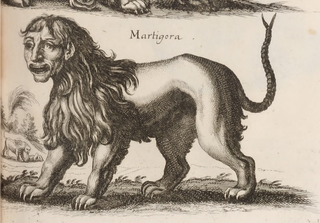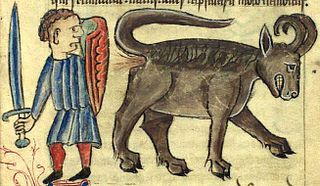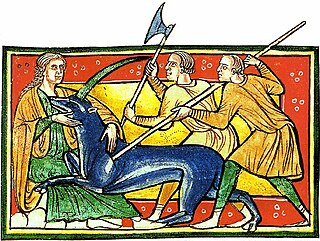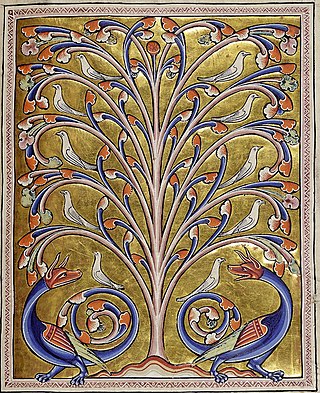
The Aberdeen Bestiary is a 12th-century English illuminated manuscript bestiary that was first listed in 1542 in the inventory of the Old Royal Library at the Palace of Westminster. Due to similarities, it is often considered to be the "sister" manuscript of the Ashmole Bestiary. The connection between the ancient Greek didactic text Physiologus and similar bestiary manuscripts is also often noted. Information about the manuscript's origins and patrons are circumstantial, although the manuscript most likely originated from the 13th century and was owned by a wealthy ecclesiastical patron from north or south England. Currently, the Aberdeen Bestiary resides in the Aberdeen University Library in Scotland.

A bestiary is a compendium of beasts. Originating in the ancient world, bestiaries were made popular in the Middle Ages in illustrated volumes that described various animals and even rocks. The natural history and illustration of each beast was usually accompanied by a moral lesson. This reflected the belief that the world itself was the Word of God and that every living thing had its own special meaning. For example, the pelican, which was believed to tear open its breast to bring its young to life with its own blood, was a living representation of Jesus. Thus the bestiary is also a reference to the symbolic language of animals in Western Christian art and literature.

The Physiologus is a didactic Christian text written or compiled in Greek by an unknown author in Alexandria. Its composition has been traditionally dated to the 2nd century AD by readers who saw parallels with writings of Clement of Alexandria, who is asserted to have known the text, though Alan Scott has made a case for a date at the end of the 3rd or in the 4th century. The Physiologus consists of descriptions of animals, birds, and fantastic creatures, sometimes stones and plants, provided with moral content. Each animal is described, and an anecdote follows, from which the moral and symbolic qualities of the animal are derived. Manuscripts are often, but not always, given illustrations, often lavish.

In Greek mythology, sirens are humanlike beings with alluring voices; they appear in a scene in the Odyssey in which Odysseus saves his crew's lives. Roman poets place them on some small islands called Sirenum scopuli. In some later, rationalized traditions, the literal geography of the "flowery" island of Anthemoessa, or Anthemusa, is fixed: sometimes on Cape Pelorum and at others in the islands known as the Sirenuse, near Paestum, or in Capreae. All such locations were surrounded by cliffs and rocks.

The manticore or mantichore is a Persian legendary creature similar to the Egyptian sphinx that proliferated in Western European medieval art as well. It has the head of a human, the body of a lion, and the tail of a scorpion or a tail of venomous spines similar to porcupine quills. There are some accounts that the spines can be launched like arrows. It eats its victims whole, using its three rows of teeth, and leaves no bones behind.

The bonnacon is a legendary creature described as a bull with inward-curving horns and a horse-like mane. Medieval bestiaries usually depict its fur as reddish-brown or black. Because its horns were useless for self-defense, the bonnacon was said to expel large amounts of caustic feces from its anus at its pursuers, burning them and thereby ensuring its escape.

The crocotta or corocotta, crocuta, or leucrocotta is a mythical dog-wolf of India or Aethiopia, linked to the hyena and said to be a deadly enemy of men and dogs.

Hugh of Fouilloy was a French cleric, prior of St.-Nicholas-de-Regny (1132) and St.-Laurent-au-Bois (1152). He is notable for writing De claustro animae and De medicina animae, allegorical texts on monastic spirituality. His De avibus, a moral treatise on birds was incorporated into many versions of the popular medieval bestiary.

The Ashmole Bestiary, an English illuminated manuscript bestiary, is from the late 12th or early 13th century. Under 90 such manuscripts survive and they were studied and categorized into families by M.R. James in 1928. The Ashmole Bestiary is part of the Second-family of manuscript Latin bestiaries, wherein it is one of forty eight. The "Second-family" bestiary is the most popular and widely distributed type of these manuscripts. It is of English origin, with a spiritual text that catered to the prevailing culture of the church at the time. The stimulating illuminations are not just decorative, as many people were illiterate or semi-literate in England at the time. All true Latin Bestiaries take their origin from the Greek work Physiologus, though the word can colloquially be used with less specificity.

According to the tradition of the Physiologus and medieval bestiaries, the aspidochelone is a fabled sea creature, variously described as a large whale or vast sea turtle, and a giant sea monster with huge spines on the ridge of its back. No matter what form it is, it is always described as being so huge that it is often mistaken for a rocky island covered with sand dunes and vegetation. The name aspidochelone appears to be a compound word combining Greek aspis, and chelone, the turtle. It rises to the surface from the depths of the sea, and entices unwitting sailors with its island appearance to make landfall on its huge shell and then the whale is able to pull them under the ocean, ship and all the people, drowning them. It also emits a sweet smell that lures fish into its trap where it then devours them. In the moralistic allegory of the Physiologus and bestiary tradition, the aspidochelone represents Satan, who deceives those whom he seeks to devour.
The idea that there are specific marine counterparts to land creatures, inherited from the writers on natural history in Antiquity, was firmly believed in Islam and in Medieval Europe. It is exemplified by the creatures represented in the medieval animal encyclopedias called bestiaries, and in the parallels drawn in the moralising attributes attached to each. "The creation was a mathematical diagram drawn in parallel lines," T. H. White said a propos the bestiary he translated. "Things did not only have a moral they often had physical counterparts in other strata. There was a horse in the land and a sea-horse in the sea. For that matter there was probably a Pegasus in heaven". The idea of perfect analogies in the fauna of land and sea was considered part of the perfect symmetry of the Creator's plan, offered as the "book of nature" to mankind, for which a text could be found in Job:
But ask the animals, and they will teach you, or the birds of the air, and they will tell you; or speak to the earth, and it will teach you, or let the fish of the sea inform you. Which of all these does not know that the hand of the Lord has done this? In his hand is the life of every creature and the breath of all mankind.

The Myrmecoleon or Ant-lion is a fantastical animal from classical times, possibly derived from an error in the Septuagint version of the book of Job, reappearing in the Greek Christian Physiologus of the 3rd or 4th century A.D.

The Rochester Bestiary is a richly illuminated manuscript copy of a medieval bestiary, a book describing the appearance and habits of a large number of familiar and exotic animals, both real and legendary. The animals' characteristics are frequently allegorised, with the addition of a Christian moral.

The Worksop Bestiary, also known as the Morgan Bestiary, most likely from Lincoln or York, England, is an illuminated manuscript created around 1185, containing a bestiary and other compiled medieval Latin texts on natural history. The manuscript has influenced many other bestiaries throughout the medieval world and is possibly part of the same group as the Aberdeen Bestiary, Alnwick Bestiary, St.Petersburg Bestiary, and other similar Bestiaries. Now residing in the Morgan Library & Museum in New York, the manuscript has had a long history of church, royal, government, and scholarly ownership.

The Icelandic Physiologus is a translation into Old Icelandic of a Latin translation of the 2nd-century Greek Physiologus. It survives in fragmentary form in two manuscripts, both dating from around 1200, making them the earliest illustrated manuscripts from Iceland and among the earliest Icelandic manuscripts generally. The fragments are significantly different from each other and either represent copies from two separate exemplars or different reworkings of the same text. Both texts also contain material that is not found in standard versions of the Physiologus.
Philip de Thaun was the first Anglo-Norman poet. He is the first known poet to write in the Anglo-Norman French vernacular language, rather than Latin. Two poems by him are signed with his name, making his authorship of both clear. A further poem is probably written by him as it bears many writing similarities to his other two poems.

The spotted hyena has a long history of interaction with humanity; depictions of the species exist from the Upper Paleolithic period, with carvings and paintings from the Lascaux and Chauvet Caves. The species has a largely negative reputation in both Western culture and African folklore. In the former, the species is mostly regarded as ugly and cowardly, while in the latter, it is viewed as greedy, gluttonous, stupid, and foolish, yet powerful and potentially dangerous. The majority of Western perceptions on the species can be found in the writings of Aristotle and Pliny the Elder, though in relatively unjudgmental form. Explicit, negative judgments occur in the Physiologus, where the animal is depicted as a hermaphrodite and grave-robber. The IUCN's hyena specialist group identifies the spotted hyena's negative reputation as detrimental to the species' continued survival, both in captivity and the wild.

The peridexion tree or perindens is a mythological tree discussed in the Physiologus, an early Greek-language Christian didactic text and compendium, and popular in medieval bestiaries. It is described as growing in India, attracting doves and deterring serpents, making for a fable about Christian salvation.

The Zirc Bestiary is a 15th-century Hungarian illuminated manuscript copy of a medieval bestiary, a book describing the appearance and habits of a number of familiar and exotic animals, both real and legendary. The animals' characteristics are frequently allegorized, with the addition of a Christian moral. The Latin-language work was kept in the Cistercian Zirc Abbey, now it belongs to the property of the National Széchényi Library (OSZK).

























